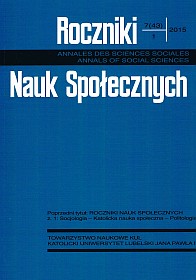Forever (Un)stable Regimes? The Comparison of Kazakhstan and Kyrgyzstan
Abstrakt
Wiecznie (nie)stabilne systemy? Porównanie Kazachstanu i Kirgistanu
Drogi przemian politycznych, stabilności i przywództwa są różne w przypadku Kazachstanu i Kirgistanu. Z jednej strony, prezydent Kazachstanu N. Nazarbajew z powodzeniem poradził sobie ze skalą problemów dotykających jego państwo, z drugiej strony, w latach 2005-2010 Kirgistan znalazł się na etapie protestów, rewolucji i niestabilności. W celu wyjaśnienia różnic między systemami politycznymi tych dwóch państw, autor skupia się w niniejszym artykule na trzech wymiarach: politycznym, ekonomicznym i poziomie bezpieczeństwa. Pomimo ogromnej różnicy ekonomicznej między tymi państwami, prezydenci Kirgistanu mogą być postrzegani jako skuteczni w utrzymywaniu swojej pozycji. Jednak, mimo korzystania z podobnych narzędzi (zasobów) – jak w Kazachstanie – w kwestiach politycznych i bezpieczeństwa, niemal w całej historii niepodległego Kirgistanu budowa efektywnego państwa nie została zrealizowana w sposób pomyślny.
Bibliografia
Abazov R., The Political Culture of Central Asia: A Case of Kyrgyzstan, March 2003, Accessed October 21, 2014, <http://mercury.ethz.ch/serviceengine/Files/ISN/44057/ichaptersection_singledocument/ba79d7dd-6c34-47b8-9770-73aaf6738f3a/en/06.pdf>.
Akbarzadeh S., Keeping Central Asia Stable, “Third World Quarterly”, Vol. 25, No. 4, 2004, pp. 689-705.
Akerman E., Democratisation in Central Asia: Communism to Clanism, “Conflict, Security & Development”, Vol. 2, No. 1, 2002, pp. 133-144.
Alkan H., Post-Soviet Politics in Kyrgyzstan: Between Centralism and Localism?, “Contemporary Politics”, Vol. 15, No. 3, September 2009, pp.355-375.
Bowyer A.C., Parliament and Political Parties in Kazakhstan, Central Asia-Caucasus Institute – Silk Road Studies Program, April 2008, Accessed October 22, 2014, <http://www.silkroadstudies.org/new/docs/Silkroadpapers/0804Bowyer.pdf>.
Cheterian V., Kyrgyzstan: Central Asia's Island of Instability, “Survival”. Global Politics and Strategy, Vol. 52, No. 5, October-November 2010, pp.21-27.
Cohen A., Kazakhstan: The Road to Independence. Energy Policy and the Birth of Nation, Central Asia-Caucasus Institute – Silk Road Studies Program, April 2008, Accessed October 20, 2014, <http://www.isdp.eu/images/stories/isdp-main-pdf/2008_cohen_ kazakhstan_the_road_to_independence.pdf>.
Collins K., Kyrgyzstan's Latest Revolution, “Journal of Democracy”, Vol. 22, No. 3, July 2011, pp. 150-164.
Cummings S.N., Power and Change in Central Asia, London–New York: Routledge 2002.
Cummings S.N., Kazakhstan Power and the Elite, London–New York: I.B. Tauris 2005.
Dzuraev S., Governance Challenges in Post-Soviet Kyrgyzstan: The Externalization and Parochialization of Political Legitimacy, 2012, Accessed October 21, 2014, .
Engvall J., Kyrgyzstan's Revolt: Prospects for Stability in aFailing State, CACI Analyst, 14.04.2010, Accessed October 23, 2014, <http://old.cacianalyst.org/?q=node/5307>.
Engvall J., Flirting with State Failure: Power and Politics in Kyrgyzstan since Independence, Central Asia-Caucasus Institute – Silk Road Studies Program, April 2011, Accessed October 21, 2014, <http://www.silkroadstudies.org/new/docs/silkroadpapers/1107Engvall.pdf>.
Franke A., Gawrich A., Autocratic Stability and Post-Soviet Rentierism: The Cases of Azerbaijan and Kazakhstan, 2011, Accessed October 20, 2014, <https://www.academia.edu/1965766/Autocratic_Stability_and_Post-Soviet_Rentierism_the_Cases_of_Azerbaijan_and_Kazakhstan>.
Frigeiro A., Kassenova N., Central Asia: Contemporary Security Challenges and Sources of State Resilience, “Security and Human Rights”, Vol. 24, No. 2, 2013, pp. 123-135.
Gleason G.M., Central Asia: State Building in the Face of Insurgent Islam, [in:] A.J. Tellis, M. Wills (eds.), Strategic Asia 2004-05: Confronting Terrorism in the Pursuit of Power, Seattle, WA: The National Bureau of Asian Research 2004, pp. 199-226.
Gürbüz Y.E, Kyrgyzstan: In Search for Stability, “Insight Turkey”, Vol. 15, No. 4, Fall 2013, pp. 191-205.
Heinrich A., The Formal Political System in Azerbaijan and Kazakhstan. ABackground Study, March 2010, Accessed October 21, 2014, <http://www.forschungsstelle.uni-bremen.de/UserFiles/file/06-Publikationen/Arbeitspapiere/fsoap107.pdf>.
Isaacs R., `Papa' – Nursultan Nazarbayev and the Discourse of Charismatic Leadership and Nation-Building in Post-Soviet Kazakhstan, “Studies in Ethnicity and Nationalism”, Vol. 10, No. 3, 2010, pp. 435-452.
Isaacs R., Party System Formation in Kazakhstan. Between Formal and Informal Politics, London–New York: Routledge 2011.
Juraev S., Back on Track? Kyrgyz Authoritarianism after the Tulip Revolution, PONARS Eurasia Policy Memo, No. 95, March 2010, Accessed October 23, 2014, <http://www.ponarseurasia.org/sites/default/files/policy-memos-pdf/pepm_095.pdf>.
Kupatadze A., Organized Crime before and after the Tulip Revolution: The Changing Dynamics of Upperworld-Underworld Networks, “Central Asian Survey”, Vol. 27, No. 3-4, 2008, pp. 279-299.
Marat E., Bakiyev, the Security Structures, and the April 7 Violence in Kyrgyzstan, CACI Analyst, 28.04.2010, Accessed October 22, 2014, <http://old.cacianalyst.org/?q=node/5316>.
Matveeva A., Kyrgyzstan in Crisis: Permanent Revolution and the Curse of Nationalism, Crisis States Working Papers, Series No. 2, September 2010, Accessed October 21, 2014, <http://mercury.ethz.ch/serviceengine/Files/ISN/121500/ipublicationdocument_singledocument/53ebff58-dae8-4f47-90fa-c7d6649ae4d1/en/WP79.2.pdf>.
Ostrovy stability a nestability v Strednej Ázii: Komparácia Kazachstanu aKirgizska, “Pretrvanie azmeny režimov v Severnej Afrike, na Blízkom východe avStrednej Ázii”, Bratislava: Vydavateľstvo UK 2014.
Rahmetov A., Kazakhstan's Presidential Elections 2011: Nazarbayev Postpones Succession, “ISPI Analysis”, No. 51, May 2011, Accessed October 21, 2014, <http://www.ispionline.it/it/documents/Analysis_51_2011.pdf>.
Way L., Resistance to Contagion: Sources of Authoritarian Stability in the Former Soviet Union, [in:] V. Bunce, M. McFaul, K. Stoner-Weiss (eds.), Democracy and Authoritarianism in the Postcommunist World, Cambridge, NY: Cambridge University Press 2010, pp. 229-252.
World Bank, GNI per capita, 2014, Accessed October 21, 2014, <http://data.worldbank.org/indicator/NY.GNP.PCAP.PP.CD>.
Copyright (c) 2015 Roczniki Nauk Społecznych

Utwór dostępny jest na licencji Creative Commons Uznanie autorstwa – Użycie niekomercyjne – Bez utworów zależnych 4.0 Międzynarodowe.


